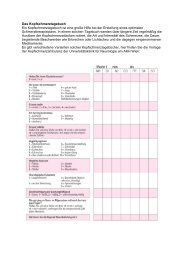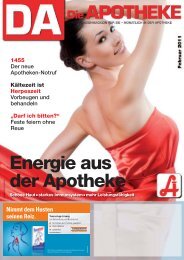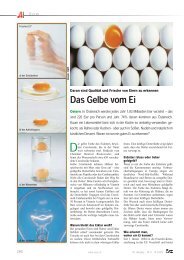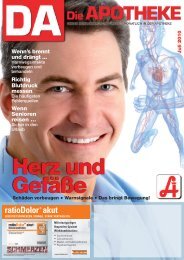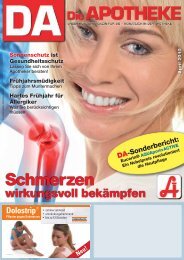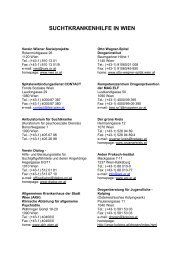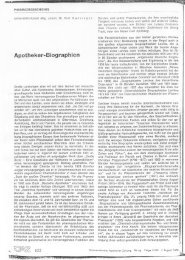The new england journal of medicine
The new england journal of medicine
The new england journal of medicine
Create successful ePaper yourself
Turn your PDF publications into a flip-book with our unique Google optimized e-Paper software.
low-dose aspirin and cardiovascular disease in women<br />
infarction was confirmed if symptoms met World<br />
Health Organization criteria and if the event was associated<br />
with abnormal levels <strong>of</strong> cardiac enzymes or<br />
diagnostic electrocardiograms. A confirmed stroke<br />
was defined as a <strong>new</strong> neurologic deficit <strong>of</strong> sudden<br />
onset that persisted for at least 24 hours. Clinical information,<br />
computed tomographic scans, and magnetic<br />
resonance images were used to distinguish<br />
hemorrhagic from ischemic events.<br />
16<br />
Death was<br />
confirmed to be from cardiovascular causes on the<br />
basis <strong>of</strong> an examination <strong>of</strong> autopsy reports, death<br />
certificates, medical records, and information obtained<br />
from the next <strong>of</strong> kin or other family members.<br />
<strong>The</strong> use <strong>of</strong> coronary revascularization (bypass<br />
surgery or percutaneous coronary angioplasty) was<br />
confirmed by a review <strong>of</strong> the medical records. A confirmed<br />
transient ischemic attack was defined as a<br />
neurologic deficit <strong>of</strong> sudden onset that lasted for<br />
less than 24 hours. Death from any cause was confirmed<br />
by the end-points committee or on the basis<br />
<strong>of</strong> a death certificate. Only confirmed end points<br />
were included in this analysis. For women with a<br />
reported myocardial infarction, the most common<br />
diagnoses among those in whom the diagnosis was<br />
not confirmed were stable or unstable angina or<br />
chest pain without evidence <strong>of</strong> infarction. For women<br />
with a reported stroke, the most common alternative<br />
diagnosis was transient cerebral ischemia.<br />
statistical analysis<br />
All primary analyses were performed on an intention-to-treat<br />
basis. <strong>The</strong> primary end point was a<br />
combination <strong>of</strong> major cardiovascular events, including<br />
nonfatal myocardial infarction, nonfatal<br />
stroke, and death from cardiovascular causes, and<br />
the trial was initially designed to have a statistical<br />
power <strong>of</strong> 86 percent to detect a 25 percent reduction<br />
in this end point. Secondary end points included<br />
the individual end points <strong>of</strong> fatal or nonfatal myocardial<br />
infarction, fatal or nonfatal stroke, ischemic<br />
stroke, hemorrhagic stroke, and death from cardiovascular<br />
causes. Additional analyses included the<br />
incidence <strong>of</strong> death from any cause, transient ischemic<br />
attack, and the need for coronary revascularization.<br />
If more than one end point occurred in a<br />
given woman, only the first event within each category<br />
was counted; for the primary combined end<br />
point, the first event in each woman was counted.<br />
Cox proportional-hazards models were used to<br />
calculate relative risks and 95 percent confidence<br />
intervals for the comparison <strong>of</strong> event rates in the aspirin<br />
and placebo groups after adjustment for age<br />
n engl j med 352;13<br />
and other randomized treatment assignments (vitamin<br />
E and beta carotene, which was a component<br />
<strong>of</strong> the trial for a median <strong>of</strong> 2.1 years17).<br />
Prespecified<br />
subgroup analyses were performed according to<br />
the presence or absence <strong>of</strong> major cardiovascular<br />
risk factors. Modification <strong>of</strong> the effect <strong>of</strong> aspirin<br />
by the risk factors was assessed with the use <strong>of</strong> interaction<br />
terms between subgroup indicators and<br />
aspirin assignment, with tests for trend performed<br />
when subgroup categories were ordinal. To examine<br />
effects among women who were compliant,<br />
we performed a sensitivity analysis in which follow-up<br />
data were censored at the time a woman reported<br />
having taken less than two thirds <strong>of</strong> the<br />
study medication during the previous year. In additional<br />
analyses, data were censored on women<br />
if and when they started taking NSAIDs more than<br />
three times a month.<br />
www.nejm.org march 31, 2005<br />
results<br />
primary analyses<br />
As shown in Table 1, the aspirin and placebo groups<br />
were similar with respect to baseline characteristics.<br />
<strong>The</strong> average duration <strong>of</strong> follow-up from randomization<br />
to the end <strong>of</strong> the trial was 10.1 years<br />
(range, 8.2 to 10.9). At the completion <strong>of</strong> the trial,<br />
999 women had had a first major cardiovascular<br />
event (Table 2), for an absolute event rate <strong>of</strong> 253 per<br />
100,000 person-years. Of these women, 477 were<br />
in the aspirin group and 522 were in the placebo<br />
group, indicating that there was a nonsignificant<br />
reduction in risk <strong>of</strong> 9 percent (relative risk, 0.91; 95<br />
percent confidence interval, 0.80 to 1.03; P=0.13).<br />
Regarding individual end points, women in<br />
the aspirin group had a 17 percent reduction in<br />
the risk <strong>of</strong> stroke (relative risk, 0.83; 95 percent<br />
confidence interval, 0.69 to 0.99; P=0.04), as compared<br />
with women in the placebo group; a 24 percent<br />
reduction in the risk <strong>of</strong> ischemic stroke (relative<br />
risk, 0.76; 95 percent confidence interval,<br />
0.63 to 0.93; P=0.009); and a nonsignificant increase<br />
in the risk <strong>of</strong> hemorrhagic stroke (relative<br />
risk, 1.24; 95 percent confidence interval, 0.82 to<br />
1.87; P=0.31) (Table 2). <strong>The</strong>re was no significant<br />
difference between the groups in the risk <strong>of</strong> fatal<br />
stroke (relative risk in the aspirin group, 1.04; 95<br />
percent confidence interval, 0.58 to 1.86; P=0.90),<br />
but the aspirin group had a decreased risk <strong>of</strong> nonfatal<br />
strokes (relative risk, 0.81; 95 percent confidence<br />
interval, 0.67 to 0.97; P=0.02), as compared<br />
with the placebo group.<br />
Downloaded from www.nejm.org on March 8, 2005 . For personal use only. No other uses without permission.<br />
Copyright © 2005 Massachusetts Medical Society. All rights reserved.<br />
ridker-3



